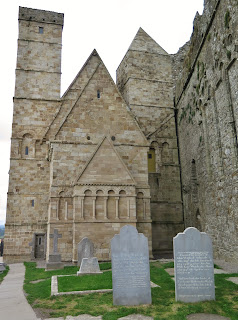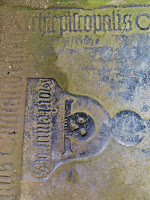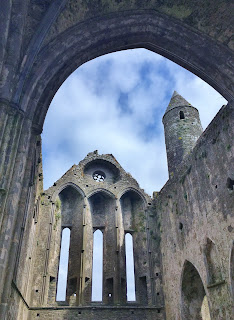Above the Plains of County Tipperary, a castle set high upon a rock outcropping dominates the skyline. The Rock Of Cashel was once a stronghold of Kings and a sacred place for Saints; now, it is a top tourist attraction for Ireland...
Travelling over the heather-covered Wicklow Mountains from Glendalough and across County Carlow to the fertile, rolling hills of County Kilkenny felt like a dramatic change. Looking at the mountains covered in farm pastures reminded me of a patchwork quilt gently pulled over the undulating land, tucking it in for a night of deep sleep. Each pasture seemed to be a different shade of green or gold and dotted with tiny cotton balls that I realized were sheep grazing in the fields. We had spent the night in a sweet little Airbnb near a small village called Freshford, between the medieval town of Kilkenny and Cashel. Once crossing into County Tippery that morning towards Cashel, the land changed again into flat pastoral farmlands that were once vast Oak forests.
 |
| Hore Abbey; Dreamy Plains of Tipperary |
County Tipperary (or Tipp, as the locals call it) is in the Province of Munster. The Rock of Cashel was once the seat of the High King of Munster from 300-1100, c.e., and you can see why. The 200-foot limestone outcropping allows for a 360-degree view of any armies advancing towards the rock. The walled fortification completely encloses the castle and is still solid 1,000 years after their building.
Here are the details for visiting the Rock of Cashel:
TIP: The Rock of Cashel is one of Irelands busiest tourist sites, so heed my warning: GO EARLY OR LATE IN THE DAY! There is a parking lot at the base of the Rock, and it cost €4.50 for the day. IT FILLS UP FAST! You could easily spend an hour or two in the morning at The Rock of Cashel and then walk down to the town of Cashel to grab lunch or do some shopping. The opening hours of the Rock are 9:00 am- 7:00pm in the summer, and the cost is €8 per person or €20 per family (unless you have your Heritage Card). You can not purchase tickets ahead of time or online, and a FREE 45-minute tour is included in your entry fee. You must pay €3 extra to tour the newly renovated Cormac's Chapel. The Rock of Cashel is run by the OPW, and their website for the Rock of Cashel is HERE.
Walking up the 100-metre road to the entrance of the Rock feels intimidating. You can't help but think of the thousands of years of history behind this mighty Gaelic Kingdom stronghold. Our tour guide told me the pre-Celtic Pagans called this place "Rock Of The Mists," and archeologists agree this was highly likely a Pagan sacred site from the first century BCE. There is strong evidence that Carraig Phádraig (the Irish name for Rock of Cashel) dates back further to the Bronze- Age 500 b.c.e, and more research is scheduled to be done at The Rock. There is a well in the centre of the Rock that probably comes from a natural spring. The first original "Caiseal " or Iron-Age stone forts and subsequent buildings were built around this well. Ask your tour guide to show you where the well is; it's almost entirely hidden near the back entrance of the Cathedral. In 1848 the well was dredged, and an ancient chalice was found!
You may notice that The Rock of Cashel is also called The Rock of Kings but is referred to as St. Patrick's Rock as well. In 450 CE, Saint Patrick came up to the Rock and baptized Ireland's last Pagan King, King Aengus, to Christianity at this sacred site. The conversion of Irish Pagans to Christianity took a very long time, and you can see evidence of this in the graveyard at the Rock of Cashel. There are some splendid Celtic High Crosses in the cemetery here. The Celtic Cross has a ring around the Latin cross representing the Sun, which was venerated by the Irish Celts, therefore trying to make Christian conversion a little easier on the Pagans.
The other early Christian symbol found on the Rock of Cashel is its impressive Round Tower. The Rock of Cashel was famously given to the Catholic Church in 1101 by Murtagh O'Brien to prevent the powerful rival McCarthy Clan from regaining its possession. The first building the Church built in 1101 when they gained possession of The Rock was the 28 meter, 3-foot thick stone round tower still in excellent shape today. This tower served as a lookout and bell tower and is a structure very unique to Ireland.
Now, you can read all about the history of Carraig Phádraig online or in books, you can look at pictures on Google Images, but I want to tell you how The Rock FEELS to me. This place is intense, the strong wind whips you, and it howls through the old stone buildings making eerie sounds. The mood is heavy and sombre, even when the sun was out. I couldn't understand why it was so majestic atop The Rock yet so desolate and even forsaken feeling - why?
Shortly after the round tower was built, The Rock of Cashel needed a "real" church to have a bishop. In 1127 the King of Cashel, Cormac McCarthy, ordered the building of a church named after him; Cormack's Chapel. The church was built in a Romanesque style. This style was influenced by continental European basilicas of the time but still very unique to all other Irish Romanesque churches. Cormack's Chapel was consecrated in 1134 and has been the bishop's official seat since 1152, and therefore needed a Cathedral; those renovations projects never end!
Do tour Cormacks Chapel; it is beautiful and contains the oldest and best-preserved frescoes in Ireland dating back to 1160-1170. This is quite a feat considering how wet Ireland is...and plaster does not like moisture. This was another trend brought to Ireland from Rome via the church. Also, the elaborately carved sarcophagus of King Cormack (or perhaps his older brother King Tadhg) is housed in the Chapel, moved here in the 1800s from its original place in the Cathedral.
The most evocative place upon The Rock of Cashel hands-down is the Gothic Cathedral. Construction began in 1169 and lasted several decades, and was finally consecrated in 1234.
Wander around in this massive, roofless structure and gaze up and imagine how glorious this Cathedral must have been in its prime, bathed in alabaster light from the enormous windows.
This is where the history of Cashel becomes dark, bloody and sad. When Oliver Cromwell's army came through during the Confederate Wars in 1647, they attacked the Catholic stronghold of Cashel. The surrounding countrysides village and townspeople (between 2,000-3,000 people) fled to the safety of the mighty Rock of Kings and into the cathedral's sanctuary. Cromwell's men packed turf around the cathedral's exterior and set it ablaze, burning all the men, women and children inside it alive. After this massacre, Cashel never regained its former splendour and stood a symbol of rebellion against the English rule. Walking on top of the medieval tombstones that line the ground and looking up to the open sky where the cathedral roof used to be, one can imagine the tragic horror that occurred in this very spot hundreds of years ago. You also get the eeriest feeling that you ...are perhaps being watched. 👻
From the 1700s on, the buildings on the Rock began to fall into sad ruin, and the bishop of Cashel moved to the village. The Rock of Kings sat derelict for hundreds of years until relatively recently when historians, archeologists and tourists have revived interest in this historic place. Renovations on the buildings are ongoing while the site remains open to the public. The Rock has also become a highly sought-after venue for theatre events, concerts and masterclasses, rejuvenating this iconic place to another incarnation (a hopefully happy one) of its long history.
Touring the Rock of Cashel is an experience I will not soon forget and provided me with a visceral lesson in Irish history.
Here are the details for visiting the Rock of Cashel:
TIP: The Rock of Cashel is one of Irelands busiest tourist sites, so heed my warning: GO EARLY OR LATE IN THE DAY! There is a parking lot at the base of the Rock, and it cost €4.50 for the day. IT FILLS UP FAST! You could easily spend an hour or two in the morning at The Rock of Cashel and then walk down to the town of Cashel to grab lunch or do some shopping. The opening hours of the Rock are 9:00 am- 7:00pm in the summer, and the cost is €8 per person or €20 per family (unless you have your Heritage Card). You can not purchase tickets ahead of time or online, and a FREE 45-minute tour is included in your entry fee. You must pay €3 extra to tour the newly renovated Cormac's Chapel. The Rock of Cashel is run by the OPW, and their website for the Rock of Cashel is HERE.
 |
| Tour Group At The Rock Of Cashel |
Walking up the 100-metre road to the entrance of the Rock feels intimidating. You can't help but think of the thousands of years of history behind this mighty Gaelic Kingdom stronghold. Our tour guide told me the pre-Celtic Pagans called this place "Rock Of The Mists," and archeologists agree this was highly likely a Pagan sacred site from the first century BCE. There is strong evidence that Carraig Phádraig (the Irish name for Rock of Cashel) dates back further to the Bronze- Age 500 b.c.e, and more research is scheduled to be done at The Rock. There is a well in the centre of the Rock that probably comes from a natural spring. The first original "Caiseal " or Iron-Age stone forts and subsequent buildings were built around this well. Ask your tour guide to show you where the well is; it's almost entirely hidden near the back entrance of the Cathedral. In 1848 the well was dredged, and an ancient chalice was found!
 |
| The Cathedral Of The Rock |
You may notice that The Rock of Cashel is also called The Rock of Kings but is referred to as St. Patrick's Rock as well. In 450 CE, Saint Patrick came up to the Rock and baptized Ireland's last Pagan King, King Aengus, to Christianity at this sacred site. The conversion of Irish Pagans to Christianity took a very long time, and you can see evidence of this in the graveyard at the Rock of Cashel. There are some splendid Celtic High Crosses in the cemetery here. The Celtic Cross has a ring around the Latin cross representing the Sun, which was venerated by the Irish Celts, therefore trying to make Christian conversion a little easier on the Pagans.
 |
| Irish High Cross in Rock of Cashel Cemetary |
The other early Christian symbol found on the Rock of Cashel is its impressive Round Tower. The Rock of Cashel was famously given to the Catholic Church in 1101 by Murtagh O'Brien to prevent the powerful rival McCarthy Clan from regaining its possession. The first building the Church built in 1101 when they gained possession of The Rock was the 28 meter, 3-foot thick stone round tower still in excellent shape today. This tower served as a lookout and bell tower and is a structure very unique to Ireland.
 |
| Round Tower Of Cashel |
Now, you can read all about the history of Carraig Phádraig online or in books, you can look at pictures on Google Images, but I want to tell you how The Rock FEELS to me. This place is intense, the strong wind whips you, and it howls through the old stone buildings making eerie sounds. The mood is heavy and sombre, even when the sun was out. I couldn't understand why it was so majestic atop The Rock yet so desolate and even forsaken feeling - why?
 |
| Cormack's Chapel Next To The Cathedral |
Do tour Cormacks Chapel; it is beautiful and contains the oldest and best-preserved frescoes in Ireland dating back to 1160-1170. This is quite a feat considering how wet Ireland is...and plaster does not like moisture. This was another trend brought to Ireland from Rome via the church. Also, the elaborately carved sarcophagus of King Cormack (or perhaps his older brother King Tadhg) is housed in the Chapel, moved here in the 1800s from its original place in the Cathedral.
 |
| Inside Cashel's Cathedral |
The most evocative place upon The Rock of Cashel hands-down is the Gothic Cathedral. Construction began in 1169 and lasted several decades, and was finally consecrated in 1234.
Wander around in this massive, roofless structure and gaze up and imagine how glorious this Cathedral must have been in its prime, bathed in alabaster light from the enormous windows.
 |
| Medieval Tombstone |
From the 1700s on, the buildings on the Rock began to fall into sad ruin, and the bishop of Cashel moved to the village. The Rock of Kings sat derelict for hundreds of years until relatively recently when historians, archeologists and tourists have revived interest in this historic place. Renovations on the buildings are ongoing while the site remains open to the public. The Rock has also become a highly sought-after venue for theatre events, concerts and masterclasses, rejuvenating this iconic place to another incarnation (a hopefully happy one) of its long history.
Touring the Rock of Cashel is an experience I will not soon forget and provided me with a visceral lesson in Irish history.
Have you ever gotten the "heebie-geebies" in a historic site? Tell me about it in the comments below...
Follow me on FACEBOOK, INSTAGRAM and BLOGLOVIN' for daily photos and updates! #slowtravel🐌 #dulgomall



No comments:
Post a Comment